What you need to know before cooking a turkey for Thanksgiving
The last Thursday of November is nigh in Oklahoma, and it's time to flip the bird into the oven, fryer or smoker.
Unless you thought way ahead and ordered a fresh bird from your local butcher, the first step in preparing the main course for the Thanksgiving feast begins with thawing, which can take a few days depending on the size of your fowl.
How long does it take to thaw a turkey?
In cold water: Thaw breast-side down, in wrapper, submerged completely in cold water. Make sure water remains cold; add ice if needed. Estimate at least 30 minutes per pound to thaw a whole turkey.
Listed here are approximate thawing times for various weights of turkey, with times for refrigerator thawing and for cold-water thawing:
10 to 12 pounds: 2 days; 4 to 6 hours.
12 to 14 pounds: 3 days; 6 to 9 hours.
14 to 18 pounds: 4 days; 9 to 14 hours.
18 pounds plus: 4 to 5 days; 14 to 24 hours.
Once the turkey is thawed, it can be treated in brine to tenderize and infuse flavor to the fowl.
How to Brine the Bird
Turkey can be thawed or fresh. Pre-basted or injected turkeys may not require brining. Check ingredient list on turkey packaging for salt, saline or broth solution.
Basic Brine
1 cup salt
1 cup sugar
2 gallons cool water
Mix salt and sugar with half of the water until dissolved. Place in clean ice chest, heavy-duty food-safe plastic bag or bucket large enough to submerge turkey. Pour brine mixture into container. Trim excess fat from cavity opening and around neck of turkey. Place turkey into brine, adding enough remaining water to cover turkey. It may be necessary to weight down turkey to keep it submerged. Place lid on ice chest. Allow turkey to remain in brine overnight or six to eight hours. Do not add additional salt to brined turkey.
Other brining options
Use apple juice in lieu of water if you’d like to reduce the salt and sugar that is used.
After brining, be sure to clean ice chest with bleach solution and rinse well.
SOURCE: The Oklahoman Archives
Turkey Recipes
CLASSIC ROASTED TURKEY
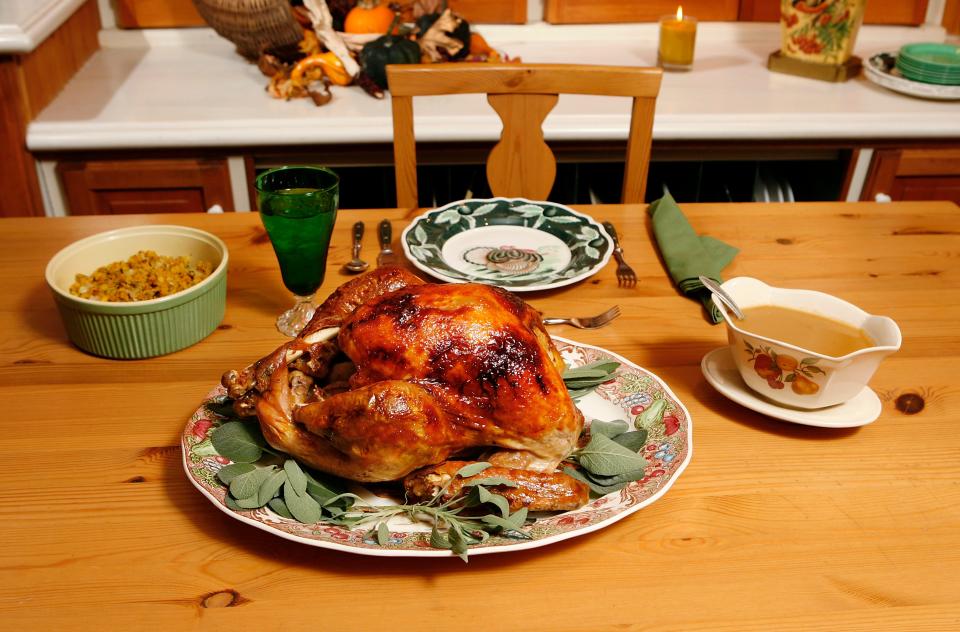
This classic method can be used with a lidded roasting pan or heavy-duty roaster with a tent of foil until final basting. Plan about 15 minutes roasting time per pound plus an additional 20 to 30 minutes resting time.
1 turkey, thawed or fresh, brined 10 to 12 hours or overnight if desired
Chicken broth to fill roaster pan an inch deep
Celery sticks to position in bottom of roaster as a rack for turkey
Fresh herbs such as parsley, thyme and sage leaves
Carrot sticks, onion slices and celery stalks to roast around turkey
1/4 cup butter (2 tablespoons softened for first basting, 2 tablespoons reserved)
2 tablespoons olive oil
1/4 cup sand plum jelly melted with reserved butter for final basting
After thawing/brining, work over sink to keep liquids from draining onto workspace. Prepare roasting vegetables. Remove giblets and neck. Trim excess fat around cavity and neck.
Adjust oven racks to fit turkey and set temperature at 325 F.
Pat turkey dry with paper towels. Coat roaster with cooking spray or butter. Place turkey in prepared roaster. Tuck wings under by bending end section behind larger section. Secure legs with butcher’s twine or silicone bands. Coat turkey’s surface with softened butter.
Surround turkey with slices of onion, carrot sections and celery stalks. Place sprigs of fresh herbs inside and around turkey, if desired. Pour broth around turkey and vegetables to a depth of 2 inches. Make a loose-fitting tent of foil, coating underside with cooking spray or butter. Secure tent over turkey so that liquids accumulating on foil will drip back into roaster. Use roaster lid if available and if it fits over turkey. Place turkey in oven.
Wash utensils with hot, soapy water and clean all surfaces that come into contact with the bird with bleach to eliminate risk of cross-contamination.
After an hour, baste turkey with pan juices using brush, spoon or turkey baster. Replace lid or foil tent. Do not baste again until about 30 minutes before turkey is done or when internal temperature is within 10 degrees of desired temperature in breast and thickest part of thigh. Melt jelly and combine with remaining butter and coat turkey. Continue roasting, uncovered, until turkey reaches internal temperature of 165 F and is golden brown.
Remove turkey from oven and allow to rest, covered, for 20 to 30 minutes before plating and carving. Use turkey lifting forks or rolling pin inserted through body cavity to transfer turkey to serving platter.
Notes: Apple slices or orange wedges may be added to vegetables in roasting pan with a few inside the turkey. These are strained out of pan juices that will be used for gravy.
SOURCE: Sherrel Jones via The Oklahoman archives
Alternative Turkey Preparations
Sweet Tea Turkey Brine

Serves: 12
1 gallon Milo's Famous Sweet Tea
1 cup kosher salt
3 large yellow onions, quartered
4 lemons, sliced
8 garlic cloves, peeled
5 sprigs rosemary
10 cups ice
In a large stock pot, combine Milo's Famous Sweet Tea and kosher salt. Heat just to boiling, stirring frequently until salt is dissolved. Add onion, lemon, garlic and rosemary. Remove from heat and let cool to room temperature.
When the broth mixture has cooled, pour it into a clean 5-gallon bucket. Stir in the ice.
Wash and dry your turkey. Making sure you have removed the innards. Place the turkey, cavity side up, into the brine. Make sure that the cavity gets filled. Cover and place the bucket in the refrigerator overnight.
Remove the turkey, carefully draining off the excess brine, and pat dry. Discard excess brine and pat dry.
Preheat oven to 325 F.
Place turkey breast side up on a flat rack in a shallow roasting pan, 2 to 2 1/2 inches deep for about 20 minutes per pound or until the bird reaches an internal temperature of 165 F.
Reserve drippings for gravy.
SOURCE: The Made in Oklahoma Coalition
Deep-Fried Turkey
1 12-to 4 pound turkey
3 to 5 gallons of peanut oil
1 pound of salt, preferably
kosher
1 cup salt
1/2 cup black pepper
1/2 cup garlic powder
1/3 cup cayenne or chile de arbol
1 pound brown sugar, optional
Before cooking, coat the propane line in soapy water, then turn on the gas. If water bubbles up, you might have a leak; go buy a smoked turkey ASAP.
Put the bird in your pot and fill it with water until the water is about 2 inches above the bird. Remove the bird. The amount of remaining water indicates how much peanut oil you'll need.
Dry out the pot and fill with the oil based on the water test. Heat the oil to 350 degrees; takes about 20 minutes. Keep an eye on your temperature and adjust it accordingly to maintain 350 degrees.
Wash the bird thoroughly and pat dry, then season with salt, pepper and chile. When the oil is ready, lower the bird into the oil and cook for about 3 minutes per pound.
Raise the bird and test its temperature with a meat thermometer. It's ready once you pass 170 degrees. Let cool 20 to 30 minutes before carving.
Source: Dave Cathey
How to carve that Thanksgiving turkey
Smallest knife
This bit of advice came to The Oklahoman back in the early 1980s from local television host BJ Wexler.
He wrote: "Set out a large cutting board and turkey platter. The 'EZ Carving System' starts with the smallest knife in the drawer, such as a paring knife.
"First, remove the drumsticks. Then, with that tiny knife, find the center breastbone and make a small incision, following the bone from head to tail. Repeat, cutting a little deeper until you are able to peel away and remove the entire turkey breast in one piece. Do the same on the other side. Cut the breasts into tasty filets. (I use an electric knife.)
"Place drumsticks on each side of the platter and arrange the turkey breasts side by side in the center finishing with the dark meat, at both ends of the platter. Don’t start carving too early. The process takes only a few minutes.
"I’ve used this carving system when I’ve been a guest for Thanksgiving dinner in many homes in Oklahoma and Texas. It’s so much fun to walk into the kitchen and offer to carve the turkey and in your next breath ask for the smallest knife in the drawer. It catches everybody’s attention."
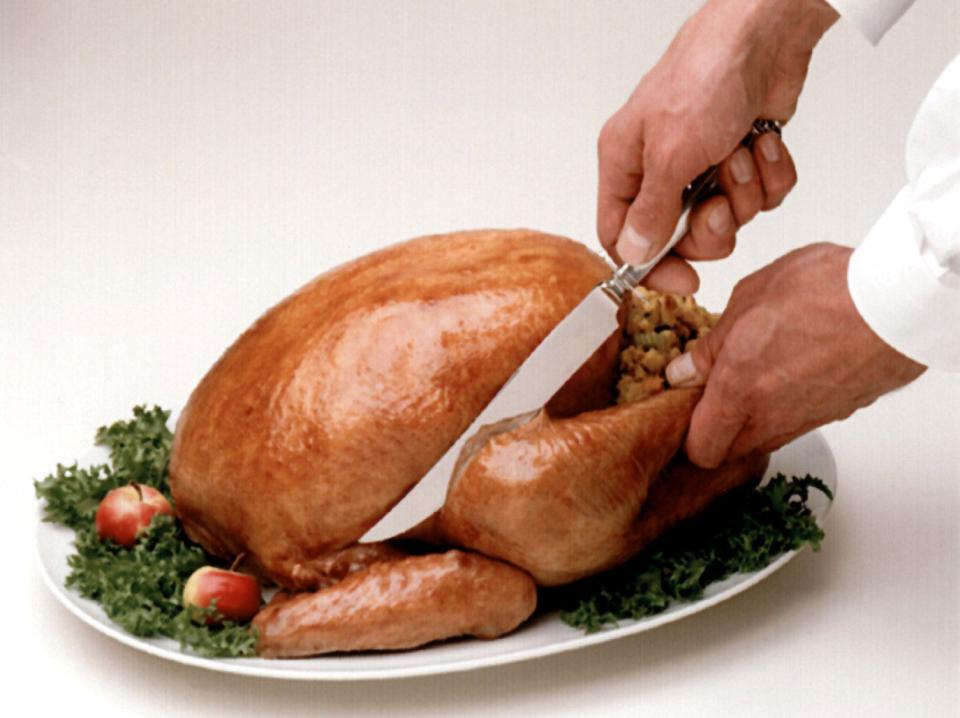
Butterball advice
Butterball offers the following instructions for carving a turkey:
First, ensure your carving knife's blade is well-honed while you're allowing the turkey to rest; about 20 minutes before starting to carve.
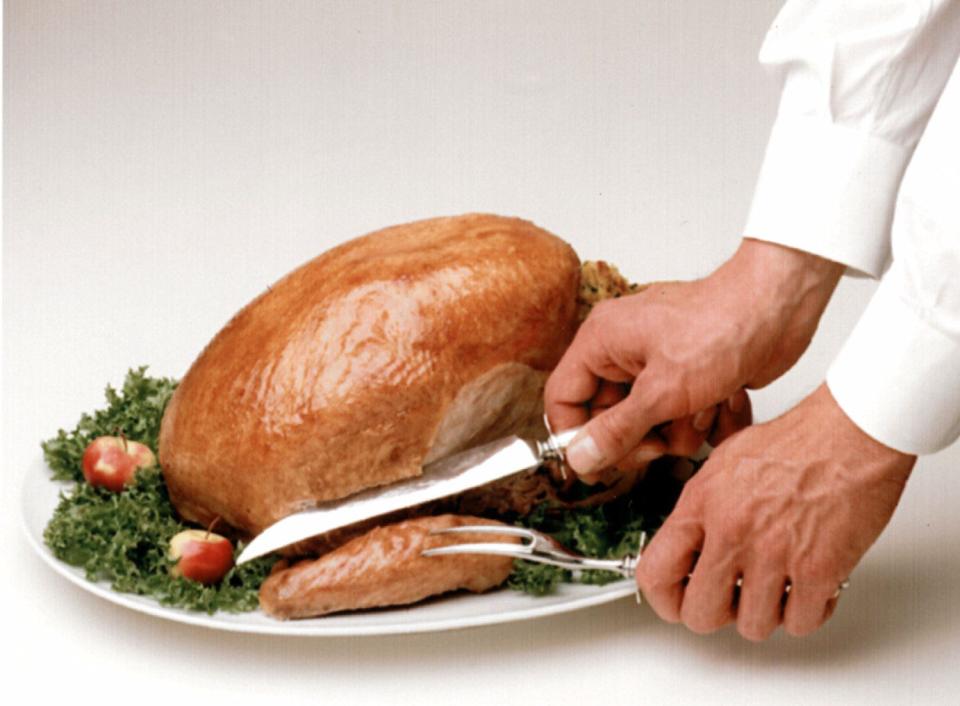
For the drumsticks, cut the band of skin holding them. Then grasp the end of one of the drumsticks, place your knife between it and the thigh/body of the turkey, and cut through the skin to the joint. Remove the entire leg by pulling out and back, using the point of the knife to disjoin it. Separate the thigh and drumstick at the joint.
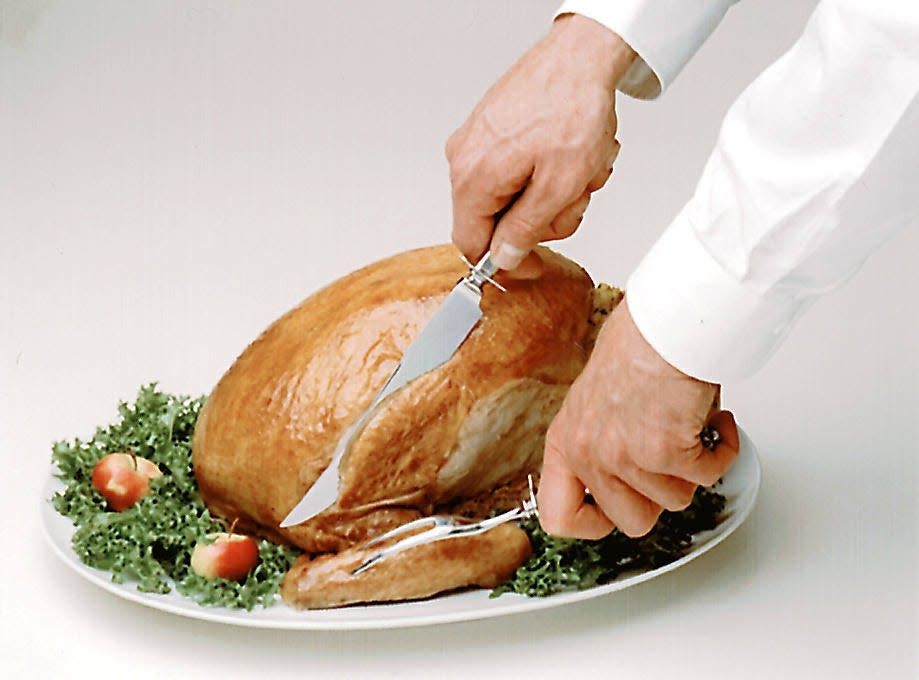
For the wings, insert a fork in the upper wing to the steady turkey. Make a long horizontal cut above the wing joint through the body frame. The wing can be disjointed from the body, if desired.
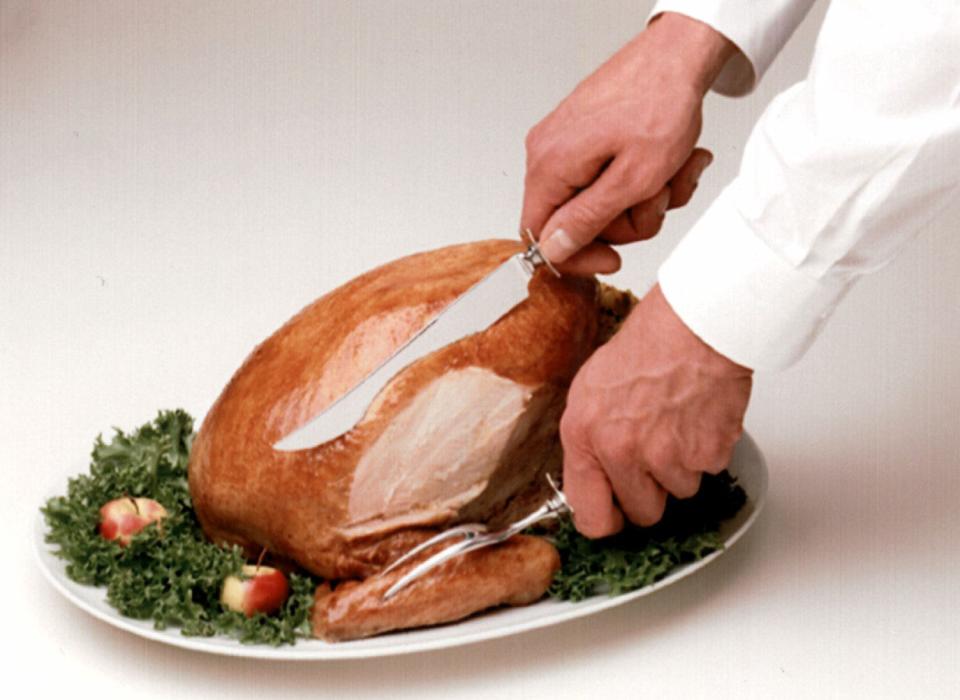
For breasts and the rest, begin halfway up the breast, slice straight down with an even stroke. When the knife reaches the cut above the wing joint, the slice should fall free on its own.
Continue to slice breast meat by starting the cut at a higher point each time.
This article originally appeared on Oklahoman: How to prepare, cook and carve a turkey for Thanksgiving

